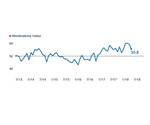Why a Decrease in Consumer Savings Is Good for Consumer Products
Consumer products goods companies should expect to do well in 2018.
According to the Bureau of Economic Analysis, consumer spending among Americans increased 2.8 percent for the year period ending February 2018. The latest available data on wages, overtime and employment indicate that in 2017 and in the initial months of 2018, workers experienced increasing incomes on average. Simultaneously, the U.S. Personal Savings Rate decreased from 3.6 percent during the fourth quarter of 2016 to 2.6 percent in the fourth quarter of 2017. This is important because income that is not deferred to savings is assumed to be spent in the present. For reference, the average savings rate since 2007 has been 5.3 percent, and the average savings rate since 1947 has been 8.5 percent.
Strong consumer confidence survey results may explain why consumers have been spending more and saving less. According to the Conference Board’s survey results (which measures current business and employment conditions), respondents’ outlook on their present situation is more positive now than at any time since 2000, including the period just prior to the Great Recession of 2008. Similarly, the Conference Board’s survey of expectations (which measures expectations six months from now) also reflects highs that the Conference Board’s survey has not experienced since the late 1990s and early 2000s. Gardner Intelligence notes that since the start of 2017, the present situation index has increased faster than the more forward-looking expectations index.
Wall Street’s average 2018 revenue outlook among nearly 60 publicly traded consumer products companies is 4.8 percent growth. Increases in wages and hours worked combined with a reduced savings rate will likely drive increased purchases through the year. 2019 revenue projections for these same firms currently stand at 3.5 percent. Gardner Intelligence believes that the lower projections for revenue growth are likely to be a result of savings rates growing closer to their long-run averages. Conversely, should wages and work hours show advances that are even stronger than anticipated in 2018 and 2019, revenue projections could be upwardly revised.
Strong revenue and earnings projections for the industry coupled with solid 2017 growth may explain why capital expenditure levels among sector firms in calendar year 2017 were 6.6 percent higher than the same period one year ago. Comparable capital expenditure growth in 2016 and 2015 was 2.8 percent and negative 1.1 percent, respectively.
About the Author
Michael Guckes
Michael Guckes is the chief economist for Gardner Intelligence, a division of Gardner Business Media (Cincinnati, Ohio, United States). He has performed economic analysis, modeling and forecasting work for nearly 20 years among a range of industries. He is available at mguckes@gardnerweb.com.
Related Content
-
Hammonton Mold, ADOP France Forge Strategic Partnership in Injection Blow Moldmaking
Hammonton Mold Inc., a leading full-service mold shop based in New Jersey specializing in injection blow molds (IBM), proudly announces its official partnership with ADOP France, a prominent IBM mold manufacturer based in Normandy, France.
-
Navigating Economic Resilience and Consumer Trends
Consumer behavior provides mold builders insight into the evolving market dynamics of goods and services that helps strategic planning.
-
Domestic Collaboration Yields Efficiency and Budget Gains For Innovative Tooling Project
Pyramid Molding Group and Lettuce Grow partner to develop optimal tooling for a compact Hydroponic Farmstand.

.jpg;width=70;height=70;mode=crop)













